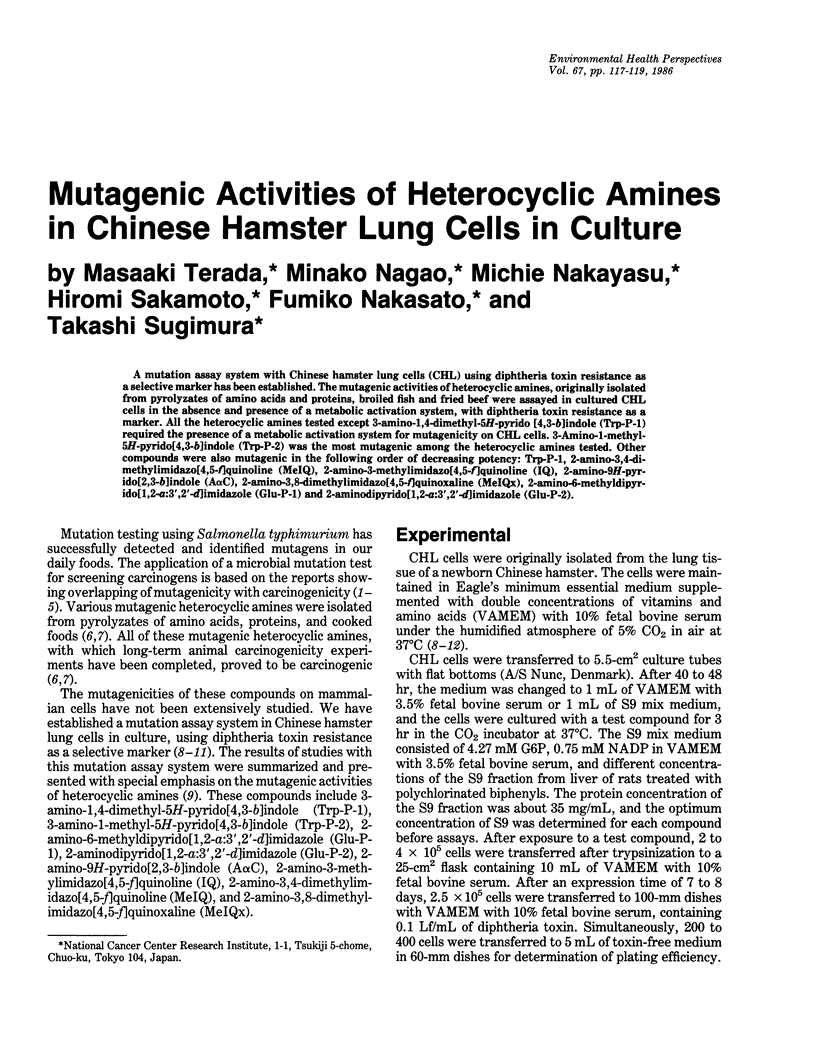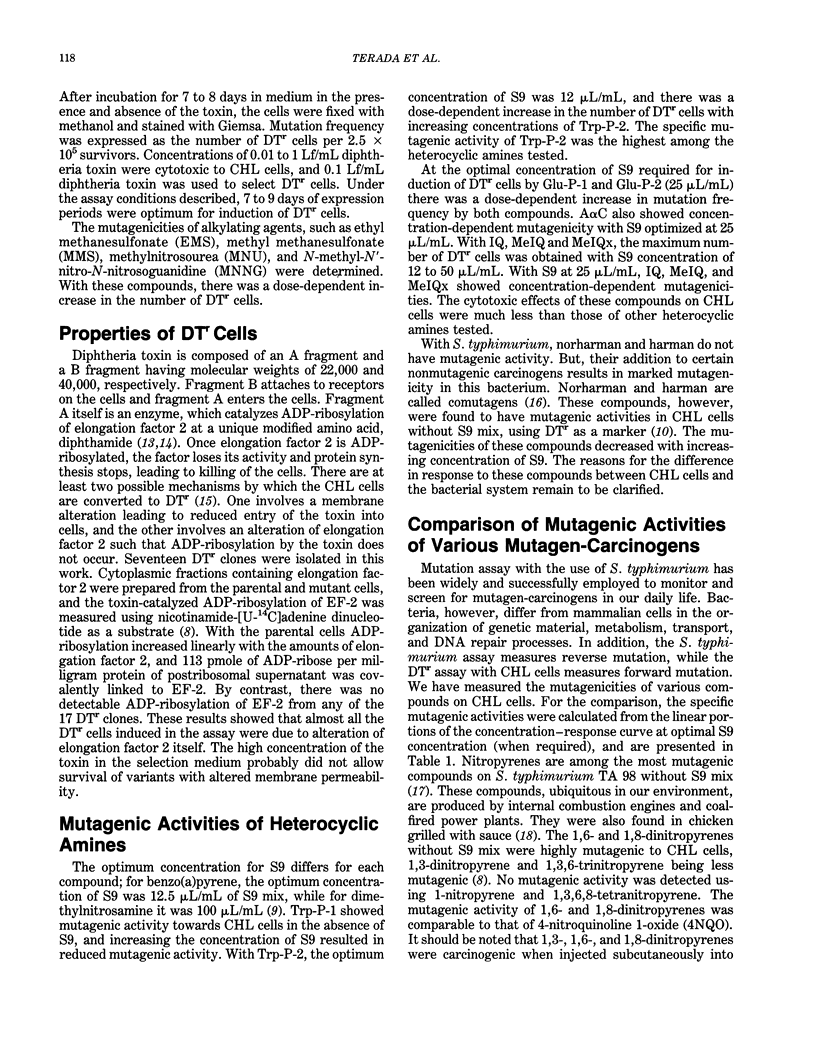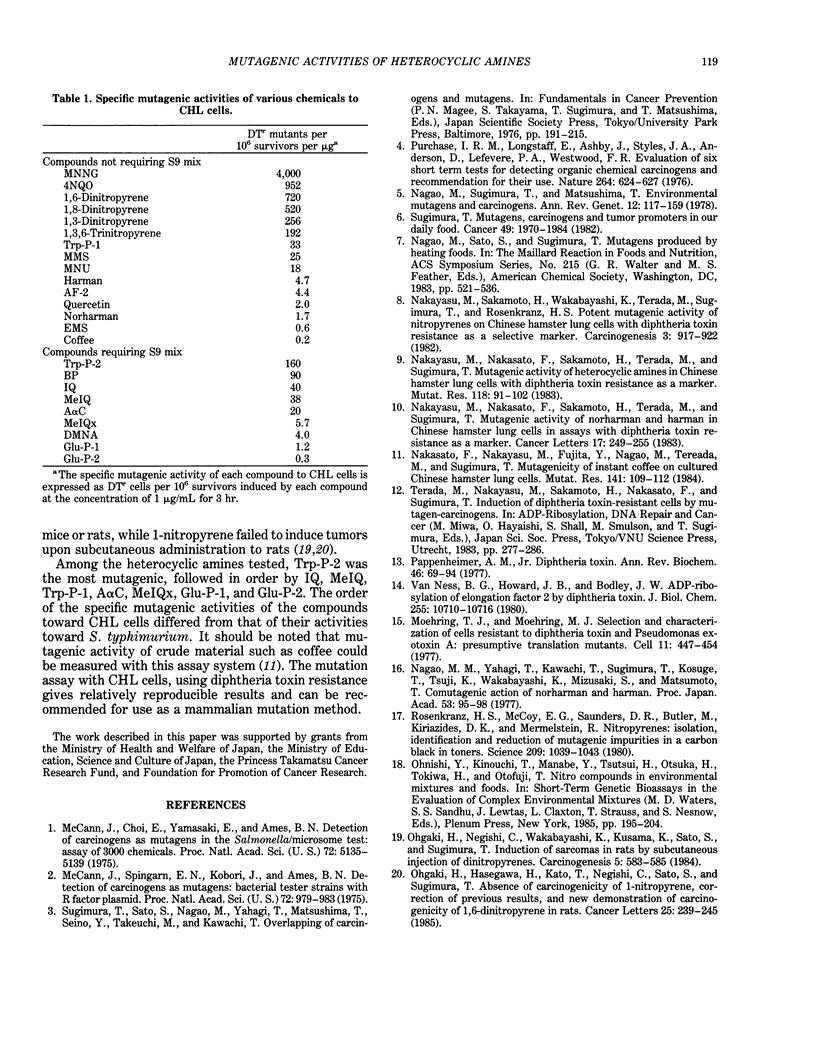Abstract
A mutation assay system with Chinese hamster lung cells (CHL) using diphtheria toxin resistance as a selective marker has been established. The mutagenic activities of heterocyclic amines, originally isolated from pyrolyzates of amino acids and proteins, broiled fish and fried beef were assayed in cultured CHL cells in the absence and presence of a metabolic activation system, with diphtheria toxin resistance as a marker. All the heterocyclic amines tested except 3-amino-1,4-dimethyl-5H-pyrido [4,3-b]indole (Trp-P-1) required the presence of a metabolic activation system for mutagenicity on CHL cells. 3-Amino-1-methyl-5H-pyrido[4,3-b]indole (Trp-P-2) was the most mutagenic among the heterocyclic amines tested. Other compounds were also mutagenic in the following order of decreasing potency: Trp-P-1, 2-amino-3,4-dimethylimidazo[4,5-f]quinoline (MeIQ), 2-amino-3-methylimidazo[4,5-f]quinoline (IQ), 2-amino-9H-pyrido[2,3-b]indole (A alpha C), 2-amino-3,8-dimethylimidazo[4,5-f]quinoxaline (MeIQx), 2-amino-6-methyldipyrido[1,2-a:3',2'-d]imidazole (Glu-P-1) and 2-aminodipyrido[1,2-a:3',2'-d]imidazole (Glu-P-2).
Full text
PDF


Selected References
These references are in PubMed. This may not be the complete list of references from this article.
- McCann J., Choi E., Yamasaki E., Ames B. N. Detection of carcinogens as mutagens in the Salmonella/microsome test: assay of 300 chemicals. Proc Natl Acad Sci U S A. 1975 Dec;72(12):5135–5139. doi: 10.1073/pnas.72.12.5135. [DOI] [PMC free article] [PubMed] [Google Scholar]
- McCann J., Spingarn N. E., Kobori J., Ames B. N. Detection of carcinogens as mutagens: bacterial tester strains with R factor plasmids. Proc Natl Acad Sci U S A. 1975 Mar;72(3):979–983. doi: 10.1073/pnas.72.3.979. [DOI] [PMC free article] [PubMed] [Google Scholar]
- Moehring T. J., Moehring J. M. Selection and characterization of cells resistant to diphtheria toxin and pseudomonas exotoxin A: presumptive translational mutants. Cell. 1977 Jun;11(2):447–454. doi: 10.1016/0092-8674(77)90063-0. [DOI] [PubMed] [Google Scholar]
- Nagao M., Sugimura T., Matsushima T. Environmental mutagens and carcinogens. Annu Rev Genet. 1978;12:117–159. doi: 10.1146/annurev.ge.12.120178.001001. [DOI] [PubMed] [Google Scholar]
- Nakasato F., Nakayasu M., Fujita Y., Nagao M., Terada M., Sugimura T. Mutagenicity of instant coffee on cultured Chinese hamster lung cells. Mutat Res. 1984 Oct;141(2):109–112. doi: 10.1016/0165-7992(84)90020-4. [DOI] [PubMed] [Google Scholar]
- Nakayasu M., Nakasato F., Sakamoto H., Terada M., Sugimura T. Mutagenic activity of heterocyclic amines in Chinese hamster lung cells with diphtheria toxin resistance as a marker. Mutat Res. 1983 Jul;118(1-2):91–102. doi: 10.1016/0165-1218(83)90119-2. [DOI] [PubMed] [Google Scholar]
- Nakayasu M., Nakasato F., Sakamoto H., Terada M., Sugimura T. Mutagenic activity of norharman and harman in Chinese hamster lung cells in assays with diphtheria toxin resistance as a marker. Cancer Lett. 1983 Jan;17(3):249–255. doi: 10.1016/0304-3835(83)90161-1. [DOI] [PubMed] [Google Scholar]
- Nakayasu M., Sakamoto H., Wakabayashi K., Terada M., Sugimura T., Rosenkranz H. S. Potent mutagenic activity of nitropyrenes on Chinese hamster lung cells with diphtheria toxin resistance as a selective marker. Carcinogenesis. 1982;3(8):917–922. doi: 10.1093/carcin/3.8.917. [DOI] [PubMed] [Google Scholar]
- Ohgaki H., Hasegawa H., Kato T., Negishi C., Sato S., Sugimura T. Absence of carcinogenicity of 1-nitropyrene, correction of previous results, and new demonstration of carcinogenicity of 1,6-dinitropyrene in rats. Cancer Lett. 1985 Jan;25(3):239–245. doi: 10.1016/s0304-3835(15)30002-1. [DOI] [PubMed] [Google Scholar]
- Ohgaki H., Negishi C., Wakabayashi K., Kusama K., Sato S., Sugimura T. Induction of sarcomas in rats by subcutaneous injection of dinitropyrenes. Carcinogenesis. 1984 May;5(5):583–585. doi: 10.1093/carcin/5.5.583. [DOI] [PubMed] [Google Scholar]
- Pappenheimer A. M., Jr Diphtheria toxin. Annu Rev Biochem. 1977;46:69–94. doi: 10.1146/annurev.bi.46.070177.000441. [DOI] [PubMed] [Google Scholar]
- Purchase I. F., Longstaff E., Ashby J., Styles J. A., Anderson D., Lefevre P. A., Westwood F. R. Evaluation of six short term tests for detecting organic chemical carcinogens and recommendations for their use. Nature. 1976 Dec 16;264(5587):624–627. doi: 10.1038/264624a0. [DOI] [PubMed] [Google Scholar]
- Rosenkranz H. S., McCoy E. C., Sanders D. R., Butler M., Kiriazides D. K., Mermelstein R. Nitropyrenes: isolation, identificaton, and reduction of mutagenic impurities in carbon black and toners. Science. 1980 Aug 29;209(4460):1039–1043. doi: 10.1126/science.6996095. [DOI] [PubMed] [Google Scholar]
- Sugimura T. Mutagens, carcinogens, and tumor promoters in our daily food. Cancer. 1982 May 15;49(10):1970–1984. doi: 10.1002/1097-0142(19820515)49:10<1970::aid-cncr2820491005>3.0.co;2-f. [DOI] [PubMed] [Google Scholar]
- Van Ness B. G., Howard J. B., Bodley J. W. ADP-ribosylation of elongation factor 2 by diphtheria toxin. NMR spectra and proposed structures of ribosyl-diphthamide and its hydrolysis products. J Biol Chem. 1980 Nov 25;255(22):10710–10716. [PubMed] [Google Scholar]


